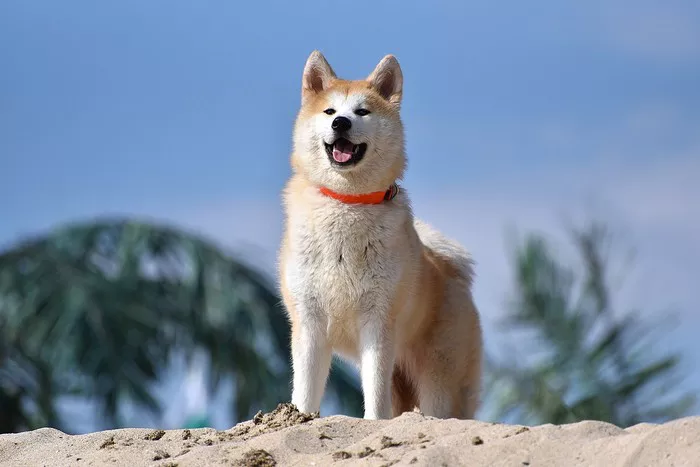Training an Akita dog requires patience, consistency, and a deep understanding of the breed’s unique characteristics. Akitas are known for their intelligence and independent nature, making training a rewarding yet sometimes challenging endeavor. In this comprehensive guide, we explore various training methods, from housetraining to enrolling in a dog training school, to help you cultivate a well-behaved and obedient Akita companion.
Housetraining
Housetraining, also known as housebreaking, is one of the initial and crucial steps in training your Akita. Akitas, like many other breeds, thrive on routine and consistency. Start by establishing a regular feeding schedule for your Akita, making it easier to predict when they need to relieve themselves. Take your Akita outside frequently, especially after meals and upon waking in the morning. When your Akita eliminates outdoors, praise and reward them, reinforcing the positive behavior. If accidents occur indoors, avoid scolding and instead clean the area thoroughly to eliminate any scent markers that might attract your Akita back to the same spot.
The Newspaper Strategy
The newspaper strategy is a valuable tool for housetraining your Akita, particularly if you live in an apartment or have limited outdoor access. Designate a specific area in your home, preferably near an entrance, where you place newspapers or training pads. When your Akita eliminates on the newspapers, offer praise and treats. As your dog becomes accustomed to using this designated area, gradually move the newspapers closer to the desired outdoor location. This method helps transition your Akita from indoor to outdoor elimination while maintaining a consistent training approach.
Crate Training
Crate training is an effective technique for providing your Akita with a safe and secure space while aiding in housetraining. Akitas, being den animals, often appreciate having their own designated space. Introduce the crate gradually, making it a positive and comfortable environment. Start by leaving the crate open and allowing your Akita to explore it at their own pace. Place treats, toys, and a comfortable blanket inside to create a positive association. As your Akita becomes more comfortable, gradually close the door for short periods, extending the time as they grow accustomed. The crate serves as a useful tool for preventing accidents when you cannot supervise your Akita and offers a secure place for them to rest.
Dog Training School
Enrolling your Akita in a dog training school provides professional guidance and structured training sessions. Akitas, with their independent nature, benefit from the socialization and obedience training offered in a group setting. Professional trainers can assess your Akita’s behavior and tailor training methods to suit their individual needs. Obedience classes typically cover essential commands such as sit, stay, come, and leash manners. The structured environment of a dog training school not only facilitates obedience but also helps your Akita learn to interact appropriately with other dogs and people. Graduating from a dog training school can significantly enhance your Akita’s social skills and overall behavior.
Socialization
Socialization is a critical aspect of training for Akitas, who may exhibit aloofness or wariness toward strangers. Start socialization from an early age by exposing your Akita to various people, environments, and experiences. Take them for walks in different neighborhoods, introduce them to friends and family members, and provide positive reinforcement for calm and friendly behavior. Use treats, praise, and toys to reward your Akita for positive interactions. Positive socialization experiences contribute to a well-adjusted and confident Akita, reducing the likelihood of fear-based aggression or anxiety in unfamiliar situations.
Positive Reinforcement
Positive reinforcement is a cornerstone of successful Akita training. Akitas respond well to positive reinforcement, which involves rewarding desired behaviors with treats, praise, or toys. When your Akita obeys a command or exhibits good behavior, immediately offer a reward. This creates a positive association with the behavior, reinforcing the likelihood of its repetition. Avoid using harsh punishments or negative reinforcement, as Akitas may become resistant or fearful. Consistency is key in positive reinforcement training, ensuring that your Akita understands the connection between their actions and the rewards they receive.
Teaching Basic Commands
Teaching basic commands lays the foundation for obedience in Akitas. Begin with simple commands like sit, stay, come, and down. Use treats and positive reinforcement to encourage your Akita to follow these commands. Break down the training sessions into short, focused intervals to keep your Akita engaged and attentive. Gradually increase the complexity of commands as your Akita becomes more proficient. Training sessions should be enjoyable for both you and your Akita, fostering a positive relationship based on trust and cooperation.
Leadership
Akitas thrive in a structured environment where they recognize you as the pack leader. Establishing yourself as the leader involves consistent training, setting clear boundaries, and being a source of guidance and support. Use calm and assertive energy during training sessions, and ensure that your Akita understands your role as the leader. Consistent rules and expectations contribute to a harmonious relationship, where your Akita feels secure and follows your guidance.
Advanced Training
Once your Akita has mastered basic commands, consider advancing to more complex training exercises. Advanced training can include agility training, advanced obedience commands, and even participation in canine sports. These activities not only provide mental stimulation for your Akita but also strengthen the bond between you and your furry companion. Advanced training is an ongoing process that keeps your Akita mentally sharp and physically active.
Conclusion
In conclusion, training an Akita requires a thoughtful and patient approach that takes into account the breed’s unique characteristics. From housetraining and crate training to enrolling in a dog training school, each method contributes to the overall development of a well-behaved and obedient Akita. Socialization, positive reinforcement, and clear leadership further enhance the training process. Remember, training is an ongoing journey that strengthens the bond between you and your Akita, fostering a harmonious and rewarding relationship based on trust, respect, and cooperation.


